Updated
Next update
See all figures from this statistics
About the statistics
The statistics shows the amount of household waste collected by municipalities. The numbers cover sorting and treatment of waste, in addition to what kind of disposal service the municipality offer to their inbitants. All municipalities have provided information on waste management through KOSTRA.
Definitions
-
Household waste: Waste coming from normal activities in households (food residuals, packaging material, paper, furniture etc.), including large objects.
Sorting for recycling is understood as waste that is sorted in households or at the waste disposal area. After sorting, the waste can go to material recovery, composting, burning with energy recovery or used as filling compounds. As an outcome from this treatment there might be a rest that in most cases is sent to landfill. Waste from waste treatment is calculated as waste from service industry.
-
The 433 municipalities are divided in to 16 groups, after population and financial regulating framework. The grouping is based on Langørgen, A., R. Aaberge og E.R. Åserud (2001): Grouping of municipalities after population and financial regulation framework 1998. Reports 2001/35, Statistics Norway.
Administrative information
-
Name: Waste from households
Topic: Nature and the environment
-
Division for Energy, Environmental and Transport Statistics
-
Municipality – data for all municipalities, with average figures for municipality-groups, counties and country without Oslo).
-
Annually
Unrevised figures are published 15 March
Revised figures are published 15 June
-
The numbers are included in Norway's Reporting of Waste statistics to Eurostat and OECD
-
Not relevant
Background
-
The purpose of the statistics is to give an overview of the waste from households. This includes amounts, sorting and treatment of waste.
In 1992, the statistics “Municipal waste” was started. These statistics included waste from service industries. In 2001, waste from service industries was taken out and the statistics was named “Household waste”.
Data for municipalities were published every third year until 2000. Since 2001 all the municipalities are reporting annually on waste management via KOSTRA. The amount of waste by municipality is annually since 2001; data collected partly from KOSTRA and partly by direct input from inter-municipal waste companies.
-
KOSTRA provides information on municipalities and county municipalities, and is used by inhabitants, media, central and local governments.
For household Waste, central users are The Norwegian Pollution Control Authority (SFT), Ministry of the Environment, county departments of environmental affairs and organisations.
-
Not relevant
-
Not relevant
-
The financial data are collected by authority in Local Government Act §49. Information regarding waste and systems for removal of refuse are collected by authority in the Pollution Control Act Section §49 and adapted to statistics after Statistics Act Section §3-2.
-
Not relevant
Production
-
Reporting of waste amounts and waste disposal systems by all municipalities. Inter- municipal waste companies report amounts of household waste for municipalities that are members of the inter- municipal waste company.
-
Municipalities and inter-municipal waste companies are reporting via KOSTRA.
-
Data are reported to KOSTRA by 15 February.
Data are controlled prior to sending by controls in the electronic questionnaire and control programs for file-extracts. Data are controlled for obvious errors and checked against country average and last year’s values.
The municipalities must respond by 15 April to report revised data after the publishing 15 March, and revision of data is in addition performed by SSB in cooperation with the municipalities. All revision must be completed and final data published by 15 June.
All municipalities have provided information on waste management by KOSTRA. The municipalities that do not take part in inter-municipal waste companies are reporting waste data via KOSTRA, whereas waste data from the municipalities that take part in inter-municipal waste companies is reported by the waste company. The amount of waste for each municipality is calculated based on inhabitants and adjusted for vacation homes. This calculation may lead to common figures for neighbour municipalities that take part in the same system for waste collection.
The reported data are adjusted for mix with waste from service industry and waste that are delivered directly from households to waste treatment plants. Directly delivered waste is added, and waste from service industry is removed from the figures.
-
Not relevant
-
Not relevant
-
The publishing in KOSTRA covers figures from 1999, starting at the time when the municipalities joined KOSTRA. In the project period for KOSTRA there has been several changes in the statistics system, which has resulted in some time series breaks.
For household waste, 2001 is the first year with key figures for all municipalities in KOSTRA.
The statistics is comparable with equivalent data back to 1992.
Accuracy and reliability
-
At publishing 15 March the data are checked by electronic controls only, and these controls do not cover all types of errors. The statistics is based on full count, but item non-response error may happen. This will result in errors in the published figures because the data is not complete. Other types of errors can also occur in the municipalities reporting.
The quality of the figures for household waste is improved. An increasing part of the waste is weighed at receipt at the waste treatment plants, and the definitions in the waste statistics is gradually well known in the municipalities.
The amount of waste from service industry in household waste is adjusted, but can still give some uncertainty. This is also applicable to waste from households that are delivered directly to the waste handling areas.
-
Not relevant
Fact sheet
Contact
-
Camilla Skjerpen
-
Mona E. Onstad

